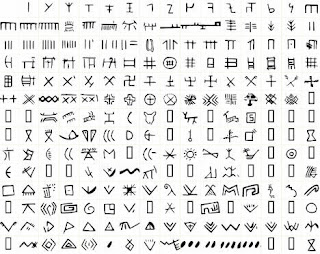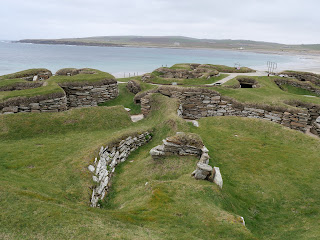The Linear Bandware Ceramic culture (LBK), with their economic focus on cattle, is considered the first
phase of the Neolithic conversion of Mesolithic (Hunter Gatherer)
Europe. The LBK made their way onto the word stage beginning roughly 5500 BC. By 4500 BC (toward the end of the LBK culture--although archaeological finds in Belgium suggest LBK existed as late as 4100 BC), Neolithic farmers
had pushed westward over the Danube's narrow headwaters from the Vinča
culture's central Balkans homeland, and down the Rhine to
the North Sea coast and Lower Belgium where it met a different set of trade nodes...and a
different interaction with Mesolithic residents of Europe.
 |
| Grooved Ware, Campbeltown Museum April 15, 2019 |
For example, recent electromagnetic induction surveys around Stonehenge revealed thousands of pits used by Mesolithic hunter-gatherers dating to about 8200 BC. And serendipitous finds of the Happisbrurgh footprints in Norfolk show human ancestors (Homo erectus) were present in Britain as far back as c. 950,000 years ago.
Paleo-genetic analyses suggest that Neolithic Belgium was a key source population in Orkney's settlement. Orkney is thought to have been settled directly from Flanders and Lower Belgium, bypassing the British mainland altogether. This necessarily implies oceanic navigation and relatively long trade routes.
Given its Middle to Late Neolithic settlement date,
Orkney was not settled by the Linear Bandware (LBK) culture, Europe's pioneer farmers. Paleo-genetic
evidence suggests Orkney was settled from Flanders (Belgium and France) apparently by the LBK's successor, the Michelsberg (MICH) culture. MICH
flourished from c.
4400 BC to 3500 BC, with an approximate ending date roughly contemporary with
Orkney's initial settlement. Since 1954 AD, a Belgium Michelsberg pottery assemblage in the British Isles has been speculated, to show an unambiguous link to the signature Grooved Ware pottery culture. To date, such evidence has yet to be discovered. It remains a key interest for Scottish archaeologists.
The Michelsberg were western Europeans. Their initial homeland was roughly northeastern France. Their type-sites, however, are concentrated in Germany's Neckar basin, a main tributary of the Rhine, near Heidelberg. The MICH pushed their settlements eastward up the Rhine, distributing along both sides of the Rhine. Evidently, the Michelsberg "absorbed" former LBK riparian lands. The expansion seems to have occurred by violent means, possibly reflected in ring dyke and causeway "fort" enclosures.
Michelsberg shared little if any cultural
affinity (or genetic
ties) with the LBK. Genetically, the Michelsberg were associated with
Neolithic farmers from the Paris Basin; but they also carried significant
hunter-gatherer (Mesolithic) ancestry. DNA tests suggest 40% to 50%.
Cattle remained a principal trade commodity with the MICH, as did flint. So, although they may not have had a cultural or genetic affinity with the LBK, economically the Michelsberg connected with LBK's cattle-oriented and fairly mobile economy. United by cattle...and parted by flint axes.
 |
| Extent of Spiennes flint mines; image Spiennes Museum |
The Neolithic Spiennes industrial mines covered over a hundred hectares and more than ten thousand shafts, some of which were cut over 52 feet in depth and required ventilation, which the Neolithic MICH "engineers" achieved by dual shafts sunk side by side and by mining in the winter which provides more optimal ventilation.
 |
| Cache of Spiennes flint long blades; image Spiennes museum |
Their extraction process was also ingenious. Enormous blocks of deep flint weighing over half a ton were undercut to free them. These blocks were left supported by rock columns and wood struts. Once sufficiently undercut, the supports were removed and the flint blocks fell to the mine gallery floor, where they were then broken up for tool cores and removed from the mine.
Part of the
Michelsberg flint tool industry included specialized workshops
(basically manufacturing villages in which mining and tool making skills
concentrated) to produce the rough outs, polished flints, picks as well
as long blades (up to a foot in length). An exclusive shop
produced axe heads and chisels. Large flint blocks were required to
create the signature Michelsberg highly standardized weapons and
tools. And the Spiennes flint resource was abundant enough to afford
the MICH an extreme level of quality control. Spiennes miners rejected many tons of flint at the bottom of their
mining shafts that were not the very best quality and size. On the surface today are scattered millions of worked flint pieces. [See: http://journals.ed.ac.uk/lithicstudies/article/view/1821/2481]
Neolithic
understanding of society was advanced well beyond that of just the
local village. They could conceptualize far more than modern humans give credit. The Neolithic was "cosmological" as modern archaeologists style it. Indeed, to settle distant Orkney, they had to be. In any case, production of flint tools and weapons at Spiennes far exceeded the local
village needs. And thus, trade networks must have existed. Neolithic trade nodes are currently poorly
understood, reliant upon needle in haystack finds. Locally, Spiennes flint was obviously the
main raw material for tools. But Spiennes polished axes,
blades and large flakes have been identified as far as 160 km (roughly 100
miles) from the mines. Doubtless, MICH trade reached further afield--and like their pottery assemblage, trade routes remain to be discovered in evidence. Whether this will be discovered in Orkney must await future archaeologists.













